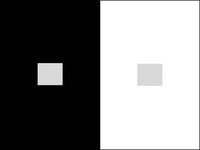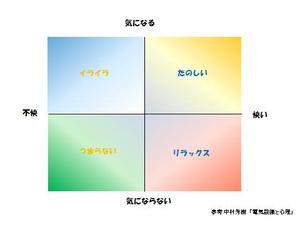Creative Café "Light Café - a calm and bright spirit and science"2/3pict
2011.07.23
*photograph of the panel which Kaneko : showed
Kaneko: I am Kaneko from chemistry major. This figure here actually represents everyone's emotion now. Earlier, everyone placed the "mind" and "don't mind" seals on the board, intuitively. This "mind" and "don't mind" actually comes from the fact that if you increase the light more, then you notice it. Conversely, if you weaken the light, then you do not notice the existence of light as much.
●Recognize the dark simultaneously with light
Kaneko: We have some guests here who tries to express the feelings in photographs that cannot be expressed in words easily.
Hatake: My name is Naoyuki Hatake, who took the photographs. Perhaps, I am always aware about making something "visible". The photograph is a record of something that can be seen by the eyes. I think that perhaps I also try to make my personal problems or what's happening in the world "visible".
Hamada: This is not only about photographs, but about light in general. When talking about light, it is quite dangerous to just recognize light. In other words, when you want to discuss about light, you must also discuss about darkness. To put it the other way around, but being aware of the darkness, the angle of light is also decided.
Yamazaki : Not only the light, but the shadow is also important. I have the feeling that there is a critical balance between light and shadow.
Hamada: I did a small experiment before. I drew a monster, cut out the shape, and projected the image to about two meter in size. Even though the origin of material is just card board, the children who saw the projection were very scared. The reason is that they involuntarily imagined that the shadow came from a monster. We tend to believe what we see. I think that Japanese people are very sensitive to light since the past. Therefore, there are some excessive feelings about light.
●Various ways to express brightness
Kaneko: I think this has become quite a deep discussion. Well then, let's change the focus to science, especially natural science, which we people at Tokyo Tech love very much. But first, let me explain a little bit about how scientists consider about the intangible light.
For instance, regarding how we feel about light, most simply, there is strength. When it's strong, it feels "dazzling"; when it's weak, it feels "uh..." For example, there is a unit "lux" for illuminance. This unit expresses the amount of incident light when a light source is projected somewhere. But, I think everyone also feels slightly that it's not the only thing. There is another new unit, luminance = [cd (candela)/m2 (meter square)] that I would like to introduce. To explain about luminance, when the light source is suddenly turned on in a confined area such as this room, the florescent light reflects from the walls and desks. The light, from one source or another, is measured by everyone's eyes, and the so-called unit of luminance...
Yamazaki : Sensei, can you please explain in a way that is easier to understand? (Laughter) For example, illuminance is the incident light that goes in the direction of someone and enters someone's eyes. On the other hand, luminance describes the reflected light after hitting some surface. Luminance includes both direct light and reflected light.
Kaneko: That's right. For example, let's think about such a place. Pretend that you take a trip to somewhere where on one side is the snowfield and the other side is the desert. The same light is applied from a similar point. Then, the illuminance that we mentioned previously is the same. The area and the amount of light that hits the surface are the same everywhere. However, because the surrounding snow reflects a lot of light when you are in the snowfield, you would feel that it is awfully dazzling. Oppositely for the desert, because there are fewer objects to reflect light, you don't feel that it's as dazzling as the snowfield. In other words, the unit for luminance = candela describes how dazzled you feel.
Yamazaki : The take-home lesson for today is that even to just simply described brightness, there are various ways and units to do this.
Let's move on to the next exercise. Please look at the gray in the black background and gray in the white background.
 When you first see this image, which one do you think is brighter?
When you first see this image, which one do you think is brighter?
D: The right one is brighter.
Kaneko: Please raise your hand if you think the right one is brighter.
Please focus on the gray square in the middle (laughter). The question is, when you focus on the gray square in the middle, does the one with the black background or the one with the white background look brighter? If you think the one with the black background looks brighter, please raise your hand. Thank you very much. Now, the people who think that the one with the white background looks brighter. Thank you very much.
Thank you for giving us the expected answer (laughter). In fact, the luminance values for both gray squares, which indicate the degree of dazzling, are identical. However, I guess everyone is not very convinced that your feeling and impression at first sight was actually wrong. About this, in recent scientific experiments, people are actually trying to express the brightness difference by quantitatively describing the degree of luminance of the front and center. The above was a scientific challenge (laughter).
Yamazaki : As mentioned by Kaneko, the brightness is the same according to the data. Depending on the surrounding light and brightness, the human eye sees colors differently. The scientific analysis is a challenge


